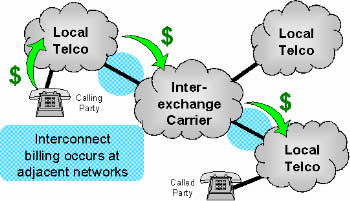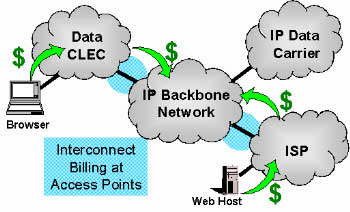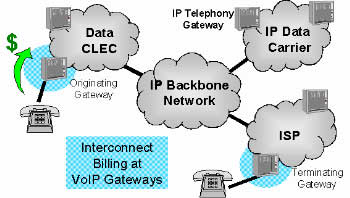|
As traditional circuit-switched telephony services become applications
using global IP (Internet protocol) data networks, the need for
authorizing and billing inter-IP domain traffic will grow. This commercial
function, known as clearing and settlement in circuit-switched telephone
networks, presents a major new revenue opportunity for IP carriers.
Clearing and settlement lets IP carriers duplicate the functionality of
a wholesale circuit-switched network, but at substantially lower costs:
it is the economic process of compensating interconnected networks for
shared traffic.
To enable revenue sharing among network providers involved in the
origination and termination of VoIP/FoIP (Voice over IP/Fax over IP)
traffic, there must be an efficient mechanism to securely authorize, route,
and rate individual calls; and to allocate or transfer revenue to the network
providers who terminate traffic at their gateways. Clearing and settlement
is the critical commercial enabler of IP telephony. Without this tracking
mechanism, there would be little revenue incentive to originate or
terminate IP telephony traffic.
INTERCONNECTION MODELS
The following sections illustrate interconnection models for existing
circuit-switched telephone networks, the World Wide Web, and IP telephony.
Circuit-Switched Interconnection
The interconnection model for the traditional circuit-switched telephone
network is shown below:

This model starts with the calling party, who pays for the
call to be completed to the called party. The originating network operator
relies on other networks to complete the call to the called party. The
circuit-switched telephony model works well because each network operator
is compensated for carrying its segment of the call.
Network operators compensate each other for the traffic they exchange
through bilateral interconnection agreements. These agreements specify how
two networks are physically interconnected at the network level. These
agreements also specify how the networks are paid on a business level.
The two interconnected carriers periodically determine how much traffic
they have sent to and received from one another. The traffic exchanges
between the two networks are netted out to yield a net traffic flow. The
net traffic flow is multiplied by the interconnection fee. The result is
a net settlement payment from the net originating network (the calling
party's network) to the net terminating network (the called party's
network).
In the circuit-switched interconnection model, network and business
interconnection occurs between adjacent networks. Network security related
to the exchange of traffic is simple since the networks have a direct
connection between tandem switches. There is no risk of fraudulent
interconnection since each operator has complete control over trunk group
installation and Call Detail Records (CDRs) generated by their switch.
Web Interconnection
The Web interconnection model is different from the
interconnection model for circuit-switched telephony in two important
ways:
First, in the circuit-switched interconnection model, wholesale network
resources are paid for on a usage basis. In the Web interconnection model,
customers and operators pay for access to network resources. With simple
access pricing, interconnection pricing is based on the size of the pipe
used to physically interconnect networks, not the volume or type of
traffic exchanged between networks. For example, a T1 connection may cost a fixed $1,500 per month regardless of the volume of
voice or data traffic exchanged between the networks.
Second, in the circuit-switched model, all service revenues are paid by
the calling party. In the Web interconnection model, revenue is derived
from both the originating and terminating networks. As shown below, the
browsing party (analogous to the calling party) pays its ISP to get access
to the Internet. The browsed party (analogous to the called party) pays
its ISP to make its Web site accessible to all browsers on the Internet.
In turn, both ISPs pay a wholesale IP network operator for access to the
Internet.

IP Telephony Interconnection
The IP telephony interconnection model is a combination of both the
circuit-switched and Web interconnection models. At the IP network
level, interconnection between the IP networks is the same as the Web
interconnection model. Smaller IP networks pay for access to an IP
backbone network.

As shown above, layered on top of the IP infrastructure are VoIP (voice
over IP) gateways located at the edge of the IP network. These gateways
convert telephone calls into IP packets for transmission across the IP
network. In a typical scenario, a telephone call will be received by an
originating VoIP gateway. The originating gateway will convert the
telephone call into a stream of IP packets that are transmitted across the
IP network to a terminating gateway. The terminating gateway receives the
IP packets and completes the telephone call to the called number. The
entire voice over IP segment of the telephone call is transparent to the
calling and called parties.
Like the traditional circuit-switched interconnection model, all
Internet telephony service revenues are generated by the calling party.
Also, like the circuit-switched interconnection model, network operators
will not complete calls on behalf of other firms unless they are
compensated for the use of their network. The Web interconnection model
ensures that the IP backbone operator is compensated for the IP traffic it
exchanges with the originating network operator. However, the Web
interconnection model offers no means for the terminating VoIP operator to
be paid for accepting the VoIP packets and completing the telephone call.
As a result, IP clearing and settlement are even more fundamental
commercial requirements for voice over IP networks than they are for
circuit-switched networks.
VALUE PROPOSITION FOR IP CARRIERS
There are several reasons IP clearing and settlement is an attractive
proposition for IP carriers (IP backbone operators):
- The IP infrastructure of these firms is well suited for handling IP
voice and fax with an acceptable quality of service.
- IP carriers are seeking ways to stimulate demand for their core
service -- wholesale IP bandwidth. Clearing and settlement is a
critical commercial enabler for IP telephony applications, and these
applications will increase demand for wholesale IP bandwidth.
- Clearing and settlement services enable IP carriers to provide their
service provider customers (ISPs, ITSPs, and CLECs) new value-added services.
Furthermore, by clearing and settling inter-network IP voice/fax
traffic, IP carriers can effectively charge higher rates for voice/fax
traffic than for commodity IP data traffic.
- An IP carrier's installed base of ISPs and CLECs represents an
existing community of users who, with a small capital investment, can
immediately benefit from inter-network clearing and settlement by
offering new value-added voice/fax services to their customers.
(Clearinghouses can provide CDRs to ISPs, ITSPs, and CLECs for billing retail
customers.)
The IP telephony business model represents a significant value
opportunity for an Internet Telephony Service Provider (ITSP) in the U.S. market.
TAPPING EXCESS NETWORK CAPACITY
In the IP telephony model, 1.5 cents per minute* is the average of all
economic costs, fixed (gateways) and variable (bandwidth and LEC
termination). Economic costs are defined as accounting costs plus profit
margin. This point is important because the mesh architecture of an IP
network does not require direct interconnection between ITSPs to exchange
IP telephony traffic. Since ITSPs are fully interconnected, the market
opportunity for them to buy or sell excess capacity at marginal economic
costs (cost + profit margin) can be very efficient and profitable for all
participants.
The economic appeal of VoIP termination is driven by two factors.
First, the peak traffic load for the average ISP offering dial-up services
occurs in the evening. The peak for telephone traffic occurs during the
day when ISPs have excess capacity available. ISPs are a natural market
for offering VoIP termination services since their traffic loads are
asymmetric with telephony traffic. Second, ISPs generate approximately 1.5
cents per minute in gross revenue for dial-up services. This 1.5 cents per
minute in gross revenue must cover all network, marketing, and customer
service expenses. ISPs would not incur marketing or customer service
expenses for IP telephony termination services. Therefore, ISPs can profit from offering IP telephony termination
service at a price well below 1.5 cents per minute. This assumption is
even more compelling if the ISP offers VoIP termination services when it
has excess capacity available.
Tapping the value of excess network capacity is not a new concept for
circuit-switched telephony operators. Traditional telephone companies have
been profitably buying and selling excess capacity at marginal economic
costs for decades. We believe, however, that an IP architecture enables
the trading of network capacity between carriers at dramatically lower
transaction costs.
* The author arrives at this figure using
list prices from Level 3 (an IP carrier) and pricing from an
interconnection agreement between BellSouth and ICG Telecom Group. For a
full explanation of this cost analysis, see TransNexus' whitepaper "The
Value Of IP Clearing And Settlement," from which this article is
adapted.
Jim Dalton is CEO of TransNexus,
a leading provider of IP network clearinghouse solutions and products.
TransNexus offers a range of standards-based clearing and settlement
solutions and products for real-time authorization, routing, clearing, and
settlement of inter-domain voice/fax communications among VoIP carriers.
TransNexus' clearinghouse solutions and products are ideal for wholesale
IP carriers and IP backbone providers wishing to become a V/FoIP
clearinghouse and offer their ISP/ITSP/CLEC customers inter-carrier
clearing and settlement of VoIP traffic as a value-added service. With the
TransNexus range of clearinghouse solutions, IP carriers can leverage
their existing IP network into a wholesale telephony network, increase
bandwidth demand derived from wholesale telephony services, and offer a
more differentiated service.
|

